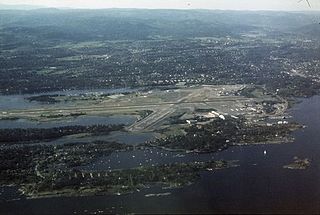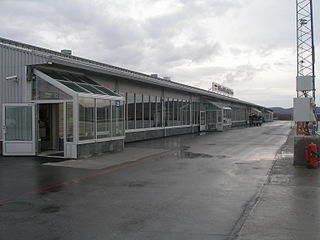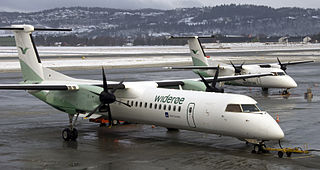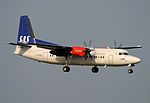Braathens ASA, until 1997 Braathens South American & Far East Airtransport A/S and trading as Braathens SAFE, was a Norwegian airline which operated from 1946 until it merged with Scandinavian Airlines (SAS) in 2004 to become SAS Braathens. For most of its history, Braathens was the largest domestic airline in Norway, but did not operate an international network for many years. Its main hubs were Oslo Airport, Fornebu and later Oslo Airport, Gardermoen, and briefly Stockholm-Arlanda Airport. The airline operated 118 aircraft of 15 models, mostly Boeing 737 variants. Braathens served 53 airports and 50 cities with scheduled services through its history.

Stavanger Airport, commonly just known as Sola, is an international airport located in Rogaland county, Norway. The airport is located 6 NM southwest of the centre of the city of Stavanger inside the neighboring municipality of Sola and it serves the Stavanger, Sola, Sandnes area as well as serves as a regional hub for southwest Norway. It is Norway's third-busiest airport, with both fixed-wing aircraft and helicopter traffic for the offshore North Sea oil installations. In addition, the Royal Norwegian Air Force operates Westland Sea King search and rescue helicopters from Sola Air Station.

Kristiansund Airport is an international airport serving Kristiansund, Norway. It is situated at Kvernberget on the island of Nordlandet and is the sole scheduled airport serving Nordmøre. The airport features a 2,390-meter (7,840 ft) runway aligned 07/25. In addition to scheduled services operated by Scandinavian Airlines and Widerøe, it serves offshore helicopter traffic to the Norwegian Sea operated by CHC Helikopter Service. Kvernberget handled 314,084 passengers in 2018.

Busy Bee was an airline which operated in Norway between 1966 and 1992. Entirely based around wet lease, it conducted a mix of regional services for larger airlines and the military, as well as corporate, ad hoc and inclusive tour charters.

Kristiansand Airport is an international airport serving Kristiansand Municipality in Agder county, Norway. The airport is located in the district of Tveit in the Oddernes borough, about 16 kilometers (9.9 mi) by road and 8 kilometers (5.0 mi) by air from the center of town of Kristiansand. Operated by the state-owned Avinor, it is the sole airport in Southern Norway with scheduled flights. It has a 2,035-meter (6,677 ft) runway aligned 03/21 and served 1,061,130 passengers in 2018. Scheduled flights are provided by Scandinavian Airlines, Norwegian Air Shuttle, Widerøe, KLM Cityhopper and Wizz Air. The Royal Norwegian Air Force has a training center at the airport.
Andøya Airport is a domestic airport located in the village of Andenes in Andøy Municipality in Nordland county, Norway. It is situated on the northern tip of the island of Andøya. The airport is the civilian sector of Andøya Air Station and is operated by the state-owned Avinor. The airport consists of two runways, 2,468 and 1,672 meters long, and served 48,254 passengers in 2012. Widerøe operates public service obligation (PSO) flights to Bodø, Tromsø, Stokmarknes and Harstad/Narvik, while Norwegian Air Shuttle operates seasonal flights to Oslo.

Harstad/Narvik Airport is an international airport located in Evenes Municipality in Nordland county, Norway. The airport serves the towns of Harstad and Narvik. It is co-located with Evenes Air Station of the Royal Norwegian Air Force. The civilian sector is owned and operated by the state-owned Avinor and handled 654,977 passengers in 2013. Evenes has a 2,808-meter (9,213 ft) runway, a parallel taxiway and a terminal with five gates. The airlines with daily scheduled services are Norwegian Air Shuttle, Scandinavian Airlines (SAS) and Widerøe. Destinations with daily services are Oslo, Trondheim, Bodø, Tromsø and Andenes. Evenes is the only primary airport in Central Hålogaland and its catchment area for Oslo-bound flights includes Lofoten and Vesterålen.

Tromsø Airport is an international airport located at Langnes in the city of Tromsø in Tromsø Municipality, Troms og Finnmark county, Norway. Situated on the western shore of the island of Tromsøya, it features a 2,447-meter (8,028 ft) runway aligned 18/36. Owned and operated by the state-owned Avinor, Langnes handled 1,910,692 passengers, 43,219 aircraft movements and 2,758 tonnes of cargo in 2014. This makes Tromsø the fifth-busiest airport in the country.

Oslo Airport, Fornebu, was the primary international airport serving Oslo and Eastern Norway from 1 June 1939 to 7 October 1998. It was then replaced by Oslo Airport, Gardermoen, and the area has since been redeveloped. The airport was located at Fornebu in Bærum, 8 km (5.0 mi) from the city center. Fornebu had two runways, one 2,370 m (7,780 ft) 06/24 and one 1,800 m (5,900 ft) 01/19, and a capacity of 20 aircraft. In 1996, the airport had 170,823 aircraft movements and 10,072,054 passengers. The airport served as a hub for Scandinavian Airlines System (SAS), Braathens SAFE and Widerøe. In 1996, they and 21 other airlines served 28 international destinations. Due to limited terminal and runway capacity, intercontinental and charter airlines used Gardermoen. The Royal Norwegian Air Force retained offices at Fornebu.

Alta Airport is an international airport serving Alta, a town and municipality in Troms og Finnmark county, Norway. The airport is located at Elvebakken, 4 kilometers (2.5 mi) east of the city center. It has a single, 2,253-meter (7,392 ft) runway numbered 11/29, which lies on the southern shore of the Altafjord. Alta Airport is owned and operated by the state-owned Avinor, and served 368,393 passengers in 2014, making it the busiest airport in Finnmark.

Kirkenes Airport is an international airport located at Høybuktmoen, 15 kilometers (9 mi) west of the town of Kirkenes, in the municipality of Sør-Varanger, Troms og Finnmark county, Norway. Operated by the state-owned Avinor, the airport has a single 2,115-by-45-meter asphalt runway numbered 05-23. Scandinavian Airlines and Norwegian Air Shuttle operate Boeing 737-services to Oslo Airport, Gardermoen, in part generated by Høybuktmoen's function as a hub for Widerøe's regional services to other airports in eastern Finnmark. There are also summer charter flights to Central Europe to bring tourists to the Hurtigruten cruises. The airport had 297,149 passengers in 2013.
Transwede Airways AB, was a Swedish charter and later also scheduled airline operating between 1985 and 1998. Based at Stockholm Arlanda Airport, Transwede initially flew Sud Aviation Caravelles, and from 1987 also McDonnell Douglas MD-80s. Most charter services were operated for package tour companies to the Mediterranean.

Hamar Airport, Stafsberg is a general aviation airport located at Stafsberg in Hamar, Norway. It features a 944-by-23-meter runway aligned 15–33 and is owned by Hamar Municipality. The airport is located in an area with very stable climate and good flying conditions.

Swedair AB was a Swedish regional airline that existed from 1935 to 1994. It was founded as Svensk Flygtjänst AB by Tor Eliasson, who was CEO until his death in 1971. The companies last manageing director was Lars svanstrom

Braathens South American & Far East Airtransport A/S or Braathens SAFE was founded by ship-owner Ludvig G. Braathen in 1946. It started as a charter airline based at Oslo Airport, Fornebu in Norway, flying to destinations in the Far East and in South America. At first the airline used Douglas DC-4s, and later also Douglas DC-3s. In 1948, the airline moved to Oslo Airport, Fornebu and started regular scheduled flights to the Far East. In 1952, the airline started cooperation with the Icelandic airline Loftleidir, where until 1960 the two airlines in cooperation flew flights to Reykjavík. Domestic services started in 1951, using de Havilland Herons on a route from Oslo to Stavanger via Tønsberg. Braathens SAFE also established at Stavanger Airport, Sola. A second route was started two years later to Trondheim. The Heron routes also stopped in Farsund, Kristiansand, Notodden to Stavanger and Hamar, Røros to Trondheim.

Braathens SAFE's domestic market was deregulated on 1 April 1994. Since then, any airline within the European Economic Area is free to operate any domestic or international route. Braathens rejected a proposal from the main competitor Scandinavian Airlines System (SAS) for a merger; instead the helicopter division was sold and the company listed on the Oslo Stock Exchange. New routes were opened from Oslo Airport, Fornebu to Bodø, Harstad/Narvik and Tromsø, but the routes from Bergen to these cities were terminated. International routes to Rome, Nice and Jersey were introduced. In 1996, Braathens SAFE bought Sweden's second-largest airline, Transwede, and started flying on the Oslo–Stockholm route. The following year, Transwede, with its five domestic routes, was merged into Braathens SAFE. The same year, KLM bought 30% of Braathens SAFE and the airlines started a partnership.

Widerøe, a regional airline based in Norway, was established by Viggo Widerøe, Einar Isdahl and Arild Widerøe on 19 February 1934. The airline started off with a combination of scheduled, aerial photography and general aviation services using seaplanes. It lost its route concessions to Norwegian Air Lines in 1935 and was subsequently bought by that company, for whom it operated several minor routes. World War II hindered Widerøe from operating any flights between 1939 and 1945. After the war Widerøe started flying various seaplane routes that were too small for DNL and its successor, Scandinavian Airlines System (SAS). These routes were commonly flown using Noorduyn Norseman and de Havilland Canada Otter aircraft. During the 1960s Widerøe attempted operating Douglas DC-3s for charter flights, but soon closed those operations.

Lakselv Airport is an international airport located at Banak, 1.5 kilometers north of Lakselv, in the municipality of Porsanger, Troms og Finnmark county, Norway. Co-located with the military Station Group Banak, the airport is owned and operated by the state-owned Avinor. The airport is also branded as North Cape Airport, although the North Cape is 190 km (120 mi) away, and the nearest airport is Honningsvåg Airport, Valan.




























